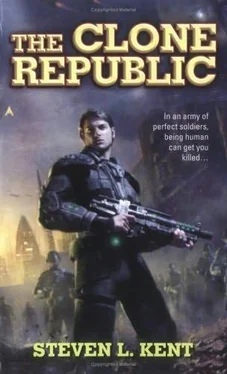Steven Kent - The Clone Republic
Здесь есть возможность читать онлайн «Steven Kent - The Clone Republic» весь текст электронной книги совершенно бесплатно (целиком полную версию без сокращений). В некоторых случаях можно слушать аудио, скачать через торрент в формате fb2 и присутствует краткое содержание. Жанр: Боевая фантастика, на английском языке. Описание произведения, (предисловие) а так же отзывы посетителей доступны на портале библиотеки ЛибКат.
- Название:The Clone Republic
- Автор:
- Жанр:
- Год:неизвестен
- ISBN:нет данных
- Рейтинг книги:5 / 5. Голосов: 1
-
Избранное:Добавить в избранное
- Отзывы:
-
Ваша оценка:
- 100
- 1
- 2
- 3
- 4
- 5
The Clone Republic: краткое содержание, описание и аннотация
Предлагаем к чтению аннотацию, описание, краткое содержание или предисловие (зависит от того, что написал сам автор книги «The Clone Republic»). Если вы не нашли необходимую информацию о книге — напишите в комментариях, мы постараемся отыскать её.
The Clone Republic — читать онлайн бесплатно полную книгу (весь текст) целиком
Ниже представлен текст книги, разбитый по страницам. Система сохранения места последней прочитанной страницы, позволяет с удобством читать онлайн бесплатно книгу «The Clone Republic», без необходимости каждый раз заново искать на чём Вы остановились. Поставьте закладку, и сможете в любой момент перейти на страницу, на которой закончили чтение.
Интервал:
Закладка:
I think Plato would have approved of neural programming had it existed in his day. Through neural programming,
U.A. scientists implanted algorithms into their soldiers’ brains like code on a computer chip. Generals and politicians collaborated on the cloning project, hammering out the perfect specimen—soldiers who respected authority and who were strong, patriotic, and ignorant of their origins.
Once Congress and the Joint Chiefs had a mix they liked, they set the oven to mass production, cranking out an average of 1.2 million new fighting men every year. Of course, the soldiers did not come out of the vat fully formed. They needed to be raised, formed in the U.A. military’s own image, and indoctrinated with the belief that God charged man to rule the galaxy.
Earth became the military-processing center, home to six hundred all-male orphanages, each of which graduated nearly two thousand combat-ready orphans per year. The orphanages were little more than clone incubators, though real orphans, like me, were sometimes brought in from the frontier.
We were the flatfoots, the conscripts. No clone or orphan ever reached officer status. The most we could hope for was sergeant. With the exception of some natural-born implants from frontier families, officers came from the ruling class. Children of politicians who did poorly in school or lacked “refinement” were shunted off to Officer Training School in Australia, a land that was originally settled as a penal colony. How ironic.
With three days of liberty before my transfer to the Scutum-Crux Fleet, I decided to visit the only home I’d ever known—Unified Authority Orphanage #553. That may sound dull or sentimental…maybe it was. I did not understand the concept of vacationing. They did not explain the concept to us in the orphanage or in basic. So with a few free days and a new promotion, I decided to go home and show the second triangle over my shoulder off to my instructors.
Located deep in the Olympic Mountains near North America’s northwest coast, #553 sat between evergreen forests and a major waterway known as the Straits of Juan de Fuca. My home was a brick-and-steel campus with a five-acre firing range, a dome-covered parade ground, and a white picket fence. It was there that I spent my youth drilling, playing, and never wondering why my classmates all looked alike.
An “entrance by permit” sign hung over the main gate of the orphanage. I ran my identity card through a reader and the automatic gate slid open, revealing the long dirt road that led to the school. This was the veil, the hedge that separated the boys from the world. The ancients thought the world was flat, and the boys of #553 thought it ended outside the automatic gate.
Walking along the road, avoiding puddles, and surveying the woods, I let my mind wander until I reached the campus itself. In the distance, I saw dormitory buildings. Home. The road stopped at the door of the administrative area—a complex of red brick buildings surrounded by a beautiful meadow. Five- and six-year-old kids, all boys and all with the same broad face and brown hair, wrestled on the wet grass. The government maintained orphanages for girls, but they were on frontier planets.
Two boys paused to stare at me as I opened the gate. They studied my uniform, noting that I had two stripes on my sleeve, not just the single stripe of a private. “Are you a Marine?” one of the boys asked in an almost worshipful tone. He knew the answer. Clone orphans learn uniforms and insignia in kindergarten.
I nodded.
“Whoa!” Both boys sighed.
I walked past them and entered the administration building. Nothing had changed at UAO #553 in the six months since my graduation. The windows sparkled, the walkways shone, the endless parade of slugs still clung to the walls. Groundskeepers squished them, poisoned them, and powdered them with salt; but still they came back, clinging to the brick like six-inch scars.
I walked past the administrative offices, down a hall past several instructional buildings, and past the cafeteria. None of those buildings interested me. I did not miss my math teachers or the counselors who held me hostage when I misbehaved. After passing the administrative building, I stepped onto the walkway that led past obstacle courses. Rifles crackled in the distance. A squad of students dressed in red athletic shorts and blue T-shirts ran across my path. Judging by their size, the boys may have been in their freshman year—fourteen years old and dying to leave the orphanage and begin boot camp. In another few years, they would report to the military induction center in Salt Lake City, where life really began.
Across a sloping hill, a squad of seniors entered the obstacle course. I knew their age because only seniors ran the course wearing combat armor. They needed it. I watched them scale walls, belly-crawl under electrical wiring, and fly across gullies using jetpacks. A line of instructors fired M27s with rubber bullets at the boys as they drilled. Armor or no armor, the bullets left inch-wide bruises wherever they hit. They would knock you senseless if they hit your helmet.
As I watched, an instructor shot down one of his boys. The kid’s arms fell limp, and his jetpack cut off as he flopped to the ground like a wet towel. The instructors ignored him and started firing at other students. The boy would survive, but he would have a ringing in his ears for the rest of the day. Like every other kid at UAO #553, I had been nailed dozens of times.
After watching two more boys get shot down, I continued toward the Tactical Training Building. Located at the far end of the campus, the TT building looked like a two-story warehouse or possibly an aircraft hangar. The building had no windows, just double-wide steel doors. Some teachers called it “the shed.”
You could not survive #553 without a mentor. Mine was Aleg Oberland—the man in charge of the Tactical Training simulations. Most cadets preferred the strapping sadists who ran the obstacle course—former enlisted men with frontline experience, battle scars, medals, and colorful stories. Oberland was the only retired officer on the teaching staff. He fought in historic campaigns—the kinds of wars that historians argue over, but he never talked about his time on the line.
He was six inches shorter than the other teachers and twenty years older. He had white hair that he kept in a thinning flattop. Most people thought of him as old and sullen, but they did not see what I did. What Oberland showed us was magic.
Oberland drilled juniors and seniors with holographic combat situations. His labs looked empty when you entered; but the moment you put on your combat visor, you would find yourself in a vivid and three-dimensional battle in a desert or on an enemy ship. Lasers in our visors projected the scenery into our eyes, painting it on our retinas, and Oberland had simulations of everything from territorial invasions to ship-to-ship combat. He even had programs simulating attacks on Washington, DC.
As I entered the dark front hall of the TT building I smelled the moldy air-conditioning, and my head filled with memories of the fear and rumors the building had inspired. Students were not allowed to enter the TT building until they turned ten, and even then, they only attended lectures on the top floor. We heard stories about what happened in the basement, but they were all false. Only students in their last two years at the orphanage could enter simulations labs, and they were not allowed to talk about it.
A spiral stairwell in the back of the building ran from the basement to the second floor. I squeezed down the stairs, brushing by dozens of students who stopped to admire my uniform. The stairs ended just outside Oberland’s classroom. Glad to be back, I opened the door and went in.
Читать дальшеИнтервал:
Закладка:
Похожие книги на «The Clone Republic»
Представляем Вашему вниманию похожие книги на «The Clone Republic» списком для выбора. Мы отобрали схожую по названию и смыслу литературу в надежде предоставить читателям больше вариантов отыскать новые, интересные, ещё непрочитанные произведения.
Обсуждение, отзывы о книге «The Clone Republic» и просто собственные мнения читателей. Оставьте ваши комментарии, напишите, что Вы думаете о произведении, его смысле или главных героях. Укажите что конкретно понравилось, а что нет, и почему Вы так считаете.












